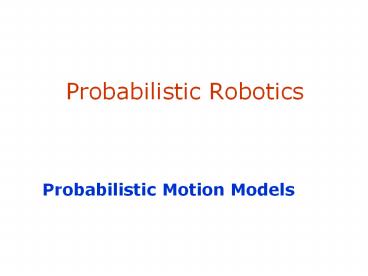Probabilistic Robotics - PowerPoint PPT Presentation
Title:
Probabilistic Robotics
Description:
... are used when systems are equipped with wheel encoders. Velocity-based models have to be applied when no wheel encoders are given. ... Example Wheel Encoders ... – PowerPoint PPT presentation
Number of Views:26
Avg rating:3.0/5.0
Title: Probabilistic Robotics
1
Probabilistic Robotics
Probabilistic Motion Models
2
Robot Motion
- Robot motion is inherently uncertain.
- How can we model this uncertainty?
3
Dynamic Bayesian Network for Controls, States,
and Sensations
4
Probabilistic Motion Models
- To implement the Bayes Filter, we need the
transition model p(x x, u). - The term p(x x, u) specifies a posterior
probability, that action u carries the robot from
x to x. - In this section we will specify, how p(x x,
u) can be modeled based on the motion equations.
5
Coordinate Systems
- In general the configuration of a robot can be
described by six parameters. - Three-dimensional cartesian coordinates plus
three Euler angles pitch, roll, and tilt. - Throughout this section, we consider robots
operating on a planar surface.
- The state space of such systems is
three-dimensional (x,y,?).
6
Typical Motion Models
- In practice, one often finds two types of motion
models - Odometry-based
- Velocity-based (dead reckoning)
- Odometry-based models are used when systems are
equipped with wheel encoders. - Velocity-based models have to be applied when no
wheel encoders are given. - They calculate the new pose based on the
velocities and the time elapsed.
7
Reasons for Motion Errors
and many more
8
Example Wheel Encoders
- These modules require 5V and GND to power them,
and provide a 0 to 5V output. They provide 5V
output when they "see" white, and a 0V output
when they "see" black.
These disks are manufactured out of high quality
laminated color plastic to offer a very crisp
black to white transition. This enables a wheel
encoder sensor to easily see the transitions.
Source http//www.active-robots.com/
9
Dead Reckoning
- Derived from deduced reckoning.
- Mathematical procedure for determining the
present location of a vehicle. - Achieved by calculating the current pose of the
vehicle based on its velocities and the time
elapsed.
10
Velocity-Based Model
11
Equation for the Velocity Model
Center of circle
with
12
Posterior Probability for Velocity Model
13
Sampling from Velocity Model
14
Examples (velocity based)
15
Odometry Model
- Robot moves from to .
- Odometry information .
16
The atan2 Function
- Extends the inverse tangent and correctly copes
with the signs of x and y.
17
Noise Model for Odometry
- The measured motion is given by the true motion
corrupted with noise.
18
Typical Distributions for Probabilistic Motion
Models
Normal distribution
Triangular distribution
19
Calculating the Probability (zero-centered)
- For a normal distribution
- For a triangular distribution
- Algorithm prob_normal_distribution(a,b)
- return
- Algorithm prob_triangular_distribution(a,b)
- return
20
Calculating the Posterior Given x, x, and u
- Algorithm motion_model_odometry(x,x,u)
- return p1 p2 p3
21
Application
- Repeated application of the sensor model for
short movements. - Typical banana-shaped distributions obtained for
2d-projection of 3d posterior.
p(xu,x)
x
x
u
u
22
Sample-based Density Representation
23
Sample-based Density Representation
24
How to Sample from Normal or Triangular
Distributions?
- Sampling from a normal distribution
- Sampling from a triangular distribution
- Algorithm sample_triangular_distribution(b)
- return
25
Normally Distributed Samples
106 samples
26
For Triangular Distribution
27
Rejection Sampling
- Sampling from arbitrary distributions
28
Example
- Sampling from
29
Sample Odometry Motion Model
- Algorithm sample_motion_model(u, x)
- Return
30
Sampling from Our Motion Model
31
Examples (Odometry-Based)
32
Map-Consistent Motion Model
33
Summary
- We discussed motion models for odometry-based and
velocity-based systems - We discussed ways to calculate the posterior
probability p(x x, u). - We also described how to sample from p(x x, u).
- Typically the calculations are done in fixed time
intervals ?t. - In practice, the parameters of the models have to
be learned. - We also discussed an extended motion model that
takes the map into account.































